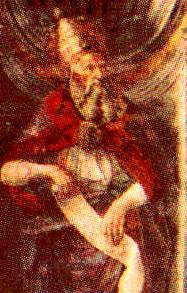Pope Anacletus
| Saint Anacletus | |
|---|---|

| |
| Birth name | Anacletus, Anencletus or Cletus |
| Papacy began | circa 79 |
| Papacy ended | circa 90 |
| Predecessor | Linus |
| Successor | Clement I |
| Born | Unknown Rome, Italy |
| Died | circa 90 Rome, Italy |
In Catholic tradition, Pope Saint Anacletus, was the third Roman Pope (after St. Peter and St. Linus). Whether he was the same as Pope Cletus, was formerly the subject of much discussion, but today both Catholic and non-Catholic authorities agree that the two were probably identical. The name "Cletus" in Ancient Greek means "one who has been called," and "Anacletus" means "one who has been called back."
According to the Liber Pontificalis, Anacletus was have a Roman, although his Greek name leads some to speculate otherwise. This source gives his reign as being 12 years. However, elsewhere it gives dates from the regnal years of certain Roman consuls that imply a reign of about half that long.
One of the few surviving records concerning his papacy describes him as having ordained an 25 priests, and tradition holds that this he who divided Rome into 25 parishes.
He is said to have died as a martyr, perhaps about the year 91. He was reportedly buried next to his predecessor, Saint Linus, in St. Peter's Basilica, in what is now Vatican City.
The Annuario Pontificio gives both forms, as alternatives. Eusebius, Saint Irenaeus, Saint Augustine and Optatus all suggest that both names refer to the same individual. On the other hand, the Liberian Catalogue and the Liber Pontificalis both state that Anacletus and Cletus are two different persons.
The Tridentine Calendar had on April 26 the feast day of Saint Cletus, honoured jointly with Saint Marcellinus, and on July 13 the feast day of Saint Anacletus. In 1960, Pope John XXIII, while keeping the April 26 feast, which mentions the saint under the name given him in the Canon of the Mass, removed that of July 13. Use of this 1960 calendar, which is included in the 1962 edition of the Roman Missal, continues to be authorized under the conditions indicated in the motu proprio Summorum Pontificum; but the April 26 feast also has been removed from the General Roman Calendar since 1969.
Cletus and Anacletus
Most contemporary scholars, including Catholics, do not believe that the office of pope existed at Rome as such during the first century CE. Rather a collective leadership of several bishops or presbyters was more likely the case. The term "pope" is thus thought to have been applied to leaders like Anacletus retroactively.
Whatever he role was, however, there is considerable uncertainty about his identity. The Church Fathers Irenaeus, Eusebius, Augustine, and Optatus, all use both "Anacletus" and "Cletus" in speaking of the same person. However, Tertullian omits him altogether, and to add to the confusion, he comes before the supposed pope Clement of Rome in some lists, and after him in others. The order of the bishops in Irenaeus is thus Linus, Anacletus, Clement; but Augustine and Optatus put Clement before Anacletus. The Apostolic Constitutions even places Clement before Linus.
On the other hand, the Catalogus Liberianus, the Carmen contra Marcionem and the Liber Pontificalis—all considered highly respectable on account of their antiquity—make Cletus and Anacletus distinct from each other. Some sources hold that Anacletus was a Greek, while Cletus as a Roman. Modern scholarship, however, has tended to agree with those authorities who consider the "two" popes as one.
Legacy
In February, 1961 the Vatican decreed that "the feast of 'Saint Anacletus'... is transferred to April 26, under its right name, 'Saint Cletus'." The Roman Martyrology mentions the Pope in question only under the name of "Cletus".[1]
The current Pontifical Yearbook (Annuario Pontificio) admits: "For the first two centuries, the dates of the start and the end of the pontificate are uncertain." It gives the years 80 to 92 as the reign of Pope Cletus/Anacletus. Other contemporary sources give the years 77 to 88.
| Roman Catholic Popes | ||
|---|---|---|
| Preceded by: Linus |
Bishop of Rome Pope 79–88 |
Succeeded by: Clement I |
Notes
- ↑ "Martyrologium Romanum" (Libreria Editrice Vaticana, 2001 ISBN 8820972107)
ReferencesISBN links support NWE through referral fees
- Donald Attwater and Catherine Rachel John, "The Penguin Dictionary of Saints," 3rd edition, New York: Penguin Books, 1993. ISBN 0-140-51312-4.
- Louise Ropes Loomis, "The Book of Popes" (Liber Pontificalis). Merchantville, NJ: Evolution Publishing. ISBN 1-889758-86-8 (Reprint of the 1916 edition. (Ends with Pope Pelagius, who reigned from 579 until 590. English translation with scholarly footnotes, and illustrations).
- Richard P. McBrien, "Lives of the Popes," (Harper, 2000). ISBN 0-06-065304-3
- This article incorporates text from the public-domain Catholic Encyclopedia of 1913.
External links
- Writings attributed to Pope Anacletus/Cletus
- The Society of Pope Saint Anacletus, an Independent Catholic association in the United States
| ||||||||||||||||
| |||||||||||||||||||||||||||||||||||||||||||||
| |||||||||||||||||||||||||||||||||||||||||
Credits
New World Encyclopedia writers and editors rewrote and completed the Wikipedia article in accordance with New World Encyclopedia standards. This article abides by terms of the Creative Commons CC-by-sa 3.0 License (CC-by-sa), which may be used and disseminated with proper attribution. Credit is due under the terms of this license that can reference both the New World Encyclopedia contributors and the selfless volunteer contributors of the Wikimedia Foundation. To cite this article click here for a list of acceptable citing formats.The history of earlier contributions by wikipedians is accessible to researchers here:
The history of this article since it was imported to New World Encyclopedia:
Note: Some restrictions may apply to use of individual images which are separately licensed.


